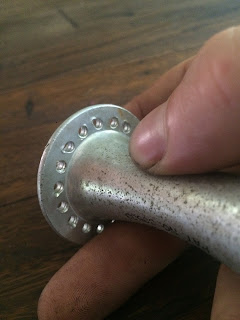Bicycle wheel bearings can be damaged, especially by over-tightening the cones and pitting the surfaces where the balls roll: balls roll between a cone on the inside, and a cup on the outside. Most frequently the cones (which screw onto the axle) are damaged, as their convex shape makes them more vulnerable (see
my post on repairing cones here). But the cups, fixed into the wheel hub, can also be damaged if treated badly enough. When they're damaged, these cups can be replaced (but nearly no-one does it).
 |
Here's a hub with a flanged cup in place at the top, and another cup on the table
|
 |
| Here's the same hub with the bearing cup knocked out |
In most hubs the bearing cups are simple parts, pressed into a concave space in each end of the hub. In many hubs the cups can be knocked out with a steel rod put through the axle space in the middle of the hub and hit with a hammer. Sometimes this is difficult if the cup can't be reached due to the shape of the hub's insides.
Cups come in different sizes, based on outside diameter, and also come with or without a flange.
 |
| Here's a few new hub cups, small at the front, big at the back, flanged on the right, plain on the left |
Cassette hubs often have a special threaded cup on the cassette side which can be spun out (left hand thread), but good luck finding replacements.
It's not easy to get replacement hub cups, but it can be done (I remember buying bike hub cups from a small town bicycle shop in Thailand in 1993). In Australia, bike shop owners can buy hub cups from a major wholesaler, Bicycle Parts Wholesale (they don't retail). Aliexpress also has several vendors selling hub cups, if you want 10,000 pairs.
We recently repaired an old front hub with new cups (bought through a wholesale account). The hub itself was quite interesting, apparently spun from aluminium tube.
 |
| looking into the spoke holes you can see the flange is made of 2 layers of folded pipe |
This hub took flanged cups, which are seated on their external rim. Replacing the cups was a piece of cake: knocking out the old cups with a rod, and pressing the new ones with a metal vice. The only complication was that one side of the hub was slightly loose around the cup: light hammering fixed it easily so the cup pressed in tightly.
 |
| Here's the reconditioned hub (new cups, re-ground cones) ready to lace into a rim |
Bicycles are really very repairable. The wearing surfaces: tyres, bearings, brake pads, rims, discs, cables...) can all be replaced after they have done a huge amount of work for us. We don't treat them like that: the culture of consumerism and novelty is well entrenched in the bicycle industry, with every encouragement provided to get people to throw away old bikes and buy new. But we don't need to do it that way. If your hub bearings are damaged, which is usually caused just by losing a few milligrams of steel from a bearing surface, it isn't necessary to throw away the whole wheel. It can be fixed and do another 100,000km (if you don't tighten the bearings too much!).

Great article. I agree that it's just dumb to change the whole wheel because of a worn cup and bearings. Thanks.
ReplyDeletecan you tell me if the shimano fh 4600 has a replaceable cup? mine got slightly damaged inside
ReplyDeleteHi. Can you explain exactly where you hammered the hub to make the cup snug? Thanks.
ReplyDeleteWhere can I buy a cup in the US all my local shops said they don't do that or sell those? They all are trying to sell me a new wheel. I self repair everything I just can't seem to locate these. 29mm outer flanged and 26mm inner bearing
ReplyDelete